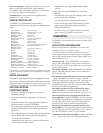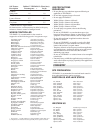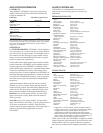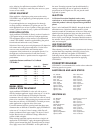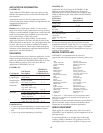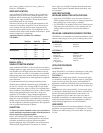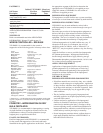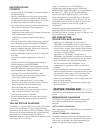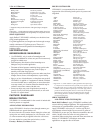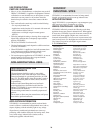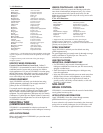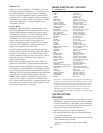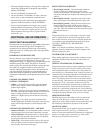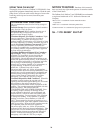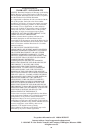
2 3/4 – 4 1/2 Pints/Acre
* Suppression may result with some of the giant (larger) smutgrass
species.
Suppression – a visible reduction in plant population and/or plant vigor
as compared to an untreated area and generally not accepted as control.
SPRAY EQUIPMENT
Apply DuPont™ VELPAR® L uniformly over the desired area
using ground equipment only.
F
or ground application, use enough water for thorough coverage
usually a minimum of 25 gallons per acre. The use of a
surfactant may increase the potential for bermudagrass or
bahiagrass injury.
USE PRECAUTIONS
BERMUDAGRASS / BAHIAGRASS
• Use VELPAR® L only in stands of bermudagrass and
bahiagrass established for at least one year. Do not treat newly
sprigged or sodded areas.
• Some temporary discoloration of the bermudagrass or
bahiagrass may occur after application.
• Treatment of mixed pastures containing forage species other
than bermudagrass or bahiagrass may result in injury or
mortality to the other forage species.
• Injury may result when desirable grasses are under stress from
drought, insects, disease, cold temperature, or poor fertility.
•
Injury to or loss of desirable trees or other plants may result if
VELPAR® L is applied or if equipment is drained or flushed
on or near desirable trees or other plants, on areas where their
roots may extend, or in locations where the chemical may be
washed or moved into contact with their roots.
• Severe crop injury may occur if applications are made on
g
r
a
velly or rocky soils, thinly covered subsoils, or soils with
less than 1% org
anic ma
tter
.
PASTURE / RANGELAND
BRUSH CONTROL
VELPAR® L is recommended for the control of undesirable
brush in pasture or rangeland.
APPLICATION INFORMATION
Apply VELPAR® L from late winter through summer, pre-
budbreak until new growth hardens off.
In areas where the soil r
emains fr
oz
en dur
ing the winter and
spring rains are usually inadequate for soil activation, a fall
or winter treatment may be applied before the soil freezes.
For rates needed to control the species below, see the
Forestry - Release, Use Rates section.
BRUSH CONTROLLED
V
ELPAR® L is recommended for the control or
suppression of the following brush species in pasture and
r
angeland:
*Suppression – a visible reduction in plant population and/or plant vigor
as compared to an untreated area and generally not accepted as control.
†For Cholla cactus (tree-type cactus) apply VELPAR® L at the rate of 4
milliliter
s (mls) of pr
oduct f
or plants up to 2 f
eet tall.
Apply 8 mls of
product for Cholla cactus plants between 2 and 6 feet tall. For plants
taller than 6 feet, apply 4 mls for each additional 2 feet of height.
W
hen tr
eating plants it is desirable to make applications equally
spaced around the plant.
SPRAY EQUIPMENT
AND APPLICATION TECHNIQUES
Basal (Soil) Undiluted
- Apply VELPAR® L undiluted with
an exact-delivery handgun applicator. This equipment delivers
a thin str
eam of a predetermined volume w
hen tr
ig
g
ered.
A
pply VELPAR® L at the rate of 2–4 ml for each inch of
stem diameter at br
east height. Do not e
xceed 1/3 g
allon of
VELP
AR
®
L per acr
e per y
ear
. Dir
ect the tr
ea
tment to the soil
within 3 inches of the root collar of woody plants to be
contr
olled
.
When treating large stems and when more than one
deli
v
er
y of
VELP
AR
®
L is needed per stem, make
applications on opposite sides of the stem.
A
lder
A
lnus spp
Ash Fraxinus spp
A
spen
P
opulus spp
Birch Betula spp
Blackgum Nyssa sylvatica
Bay, sweet Magnolia virginiana
Cactus, cholla† Optunia imbricata
C
atclaw acacia
A
cacia greggii
Cedar, Eastern red Juniperus virginiana
Cherry, black Prunus serotina
Chinaberry* Melia azedarach
Deerbrush Ceanothus integerrimus
Dogwood, flowering* Cornus florida
Elm, American Ulmus Americana
Elm, Chinese Ulmus parvifolia
Hackberry, common Celtis occidentalis
Hawthorn Crataegus spp
Hazel Corylus spp
Hickory Carya spp
Huisac
he
Acacia f
arnesiana
Juniper Juniperus spp
Locust Robinia spp
Lotebush Ziziphus obtusifolia
Manzanita, Greenleaf Arctostaphylos patula
Maple, red Acer rubrum
Mesquite Prosopis glandulosa
Mulberry Morus spp
Oaks Quercus spp
Osage-orange Maclura pomifera
Persimmon Diospyros spp
Plum, wild Prunus munsoniana
Poplar, balsam Populus balsamifera
Poplar, yellow Liriodendron tulipifera
Privet Ligustrum spp
Rose, multiflora Rosa multiflora
Sassafras* Sassafras albidum
Soapweed, small (yucca) Yucca glauca
Snowbrush (varnishleaf) Ceanothus velutinus
Sourwood Oxydendrum arboretum
Sumac Rhus spp
Sweetgum Liquidambar spp
Tallow, Chinese Sapium sebiferum
Waxmyrtle Myrica cerifera
Whitebrush Aloysia gratissima
Willow Salix spp
B
arley, little
H
ordeum pusillum
B
arnyardgrass
E
chinochloa crus-galli
D
ogfennel
E
upatorium capillifolium
F
escue
F
estuca spp
L
espedeza
L
espedeza cuneata
O
xalis
O
xalis spp
P
assionflower, maypop
P
assiflora incarnate
P
epperweed, Virginia
L
epidium virginicum
P
igweed
A
maranthus spp
S
mutgrass*
S
porobolus indicus
19



